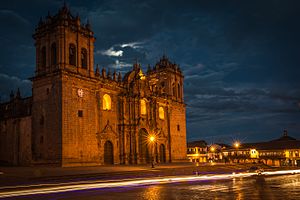
Back الدين في بيرو Arabic Religión en Perú Spanish دین در پرو Persian Religione in Perù Italian Feja në Peru Albanian
Religion in Peru (2017 Census) age: 12+ years [1][2]
| Religion by country |
|---|
|
|
| This article is part of a series on the |
| Culture of Peru |
|---|
 |
|
Peru portal |

Christianity is the most widely professed religion in Peru, with Catholicism being its largest denomination.
Religion in Peru is traditionally related to religious syncretism originating from Catholicism with the ancient Inca religion after the Spanish Conquest. However, Protestant churches of various denominations have developed considerably in the popular sectors over the past 30 years. There has been a slow but consistent advance of irreligion especially among young people in urban areas. Religions such as Judaism and Buddhism, and more recently Hinduism and Islam, are present due to immigration.
According to article 2 of the Peruvian Constitution: "Everyone has the right to freedom of conscience and religion, individually or in association. There is no persecution for reasons of ideas or beliefs. There is no crime of opinion. The public exercise of all confessions are free, as long as they do not offend morals or disturb public order."[3]
- ^ "Perú: Perfil Sociodemográfico" (PDF). Instituto Nacional de Estadística e Informática. p. 231.
- ^ "INEI - REDATAM CENSOS 2017". From Preguntas de Población/P12a+: Religión que profesa. Only asked of those 12 and older
- ^ "Political Constitution of Peru" (PDF). Portal Institucional e Información sobre la Actividad Parlamentaria y Legislativa del Estado Peruano. September 2009. Retrieved May 15, 2020.
Cite error: There are <ref group=lower-alpha> tags or {{efn}} templates on this page, but the references will not show without a {{reflist|group=lower-alpha}} template or {{notelist}} template (see the help page).